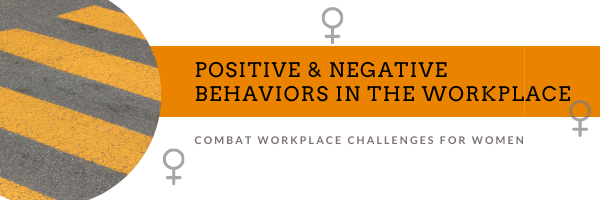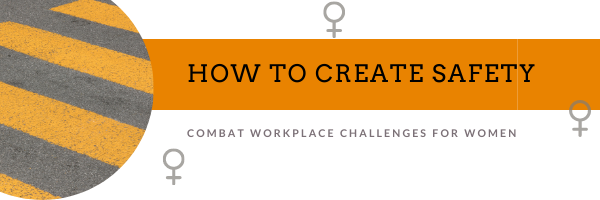9 Ways to Combat Workplace Challenges for Women

An estimated 2 million women left the workforce in 2020 due to a multitude of challenges brought on by the COVID-19 pandemic. McKinsey partnered with LeanIn.Org to conduct a women in the workplace study and the report, Women in the Workplace 2020, provides various reasons for this startling number of departures.
This exodus has the potential to erode gains made in diversity, equity, and inclusion while exposing the ongoing challenge of pay equity. As we move past the COVID-19 pandemic, many of these women will re-enter the workforce. What will they be looking for in a new employer? Leaders should take this opportunity to cultivate a strategy that will attract female workers to their organization. Ensuring a psychologically safe culture and environment will be critical to differentiating your organization to this talent pool.
Psychological safety is a belief that one will not be punished or humiliated for speaking up with ideas, questions, concerns, or mistakes. Punishment can come in a variety of forms. It can be as overt as a reprimand from your boss either verbally or in an official performance assessment. Punishment can also be stealthy like being passed over for a plum assignment often with no reason given. Or worse, being given the reason that you may not be trusted to say the “right things”. Silencing employees stifles creativity, innovation, and productivity. In fact, Google’s Project Aristotle found that psychological safety is the secret sauce to high performing teams.
Psychologically safe environments enable collaboration, offer challenging discussions, and facilitate better ideas and solutions. If employees do not feel supported raising questions or potential concerns, then products and customer service could suffer. Think of what would happen if no one on the team felt they could alert you to a key client’s preferences that were contrary to your standard operating procedures. Could forcing your processes onto the client negatively impact the relationship?
Dr. Amber Tichenor writes about the destructive impacts of female rivalry to the individual and the organization. Her personal definition of this behavior is, “Female rivalry is one woman minimizing another woman so they both feel small – smaller than they really are. Female Rivalry hurts individuals, teams and organizations.”
Female rivalry is a negative behavior and disrupts the psychological safety of the overall culture. For example, how secure someone is in their organizational setting, regarding their ability to truly be themselves, will greatly impact how they feel and how they contribute, in the sense of their ability to utilize their full potential.
If a female, or any other team member for that matter, does not feel safe in their environment… if they fear their boss, a fellow colleague, or someone in HR, they will not be able to contribute to their full potential. If a female does not feel like they can talk to or be listened to, as it pertains to a negative rivalrous type of behavior, they will not feel safe. When rampant toxicity is widespread in the workplace, good employees are unable to shine. Typically, women who experience rivalry from another woman at work, do not feel safe. And what happens then? They walk. Many leaders, because female rivalry is a topic not talked about, shake their heads in bewilderment because they have no idea why their turnover is so high and why such good people are leaving.
However, female employees in a psychologically safe environment bring their full talents, capabilities, and leadership qualities like empathy to their work. These women can contribute to their full potential and enable others to do so as well, thereby leading to an engaged, productive, and effective workforce.
There are many interpersonal behaviors that will build psychological safety when present or erode psychological safety when absent.
- Be self-aware. Know thyself – how you work best, how you communicate, how you operate under stress. If you are truly unsure where to start, there are several behavioral assessments that will provide insights and language to communicate those insights to others on your team.
- Demand self-awareness of your team. As we are all responsible for our behavior, it is equally important that your team members have insights to their working styles, communication preferences, and stressors.
- Be present. When your employees are speaking, face them and give them your full attention. Multi-tasking or facing a screen is dismissive to the employee and their ideas.
- Demonstrate understanding. Listen actively and show that you have heard your team members’ perspectives.
- Build trust – not blame. Focus on solutions and collaborations leveraging “we” statements rather than finding individuals culpable.
- Seek Input. Include your team in your decision-making process. This is not the same as consensus as you are not abdicating the decision itself, just expanding the dialogue on the considerations of the decision.
- Negate negativity. Negativity is corrosive to your organizational culture and the antithesis to psychological safety particularly when aimed at coworkers.
- Solicit Feedback. Invite your team to challenge your ideas and perspective. Ask them to push back to create a culture of healthy conflict while simultaneously showing confidence in your responsibilities. One way to conquer the potential awkwardness of these moments is to embrace humility and share previous failures.
- Give Credit. Support your employee’s personal and professional development and share their successes with senior leadership.
Committing to these behaviors and expecting them from your leaders will not only create psychological safety within your organization, the resulting cultural impact will attract diverse talent, particularly female talent into your organization. Since self-awareness is critical to creating psychologically safe workplaces for others, engaging with a leadership coach to build your self-awareness muscle is a great place to start.
Throughout her career and during the pandemic, Sara has a direct line and pulse on what people are going through in the workplace through her leadership coaching, organizational engagement and working with teams. How can Fahrenheit help your business and employees navigate through these uncertain and complex times?
About the Authors
 As Fahrenheit’s Human Capital Management Practice Area Lead, Sara Shelton brings a passion for organizational performance and creating great places to work. She enables clients to achieve their business goals by aligning and maximizing their talent, leadership, and culture. She influences with integrity and credibility, treasuring her role as consultant, advisor, and trusted confidante. She is a member of Fahrenheit’s leadership team.
As Fahrenheit’s Human Capital Management Practice Area Lead, Sara Shelton brings a passion for organizational performance and creating great places to work. She enables clients to achieve their business goals by aligning and maximizing their talent, leadership, and culture. She influences with integrity and credibility, treasuring her role as consultant, advisor, and trusted confidante. She is a member of Fahrenheit’s leadership team.
Amber Tichenor has a PhD in I/O Psychology and is a thought leader in the topic of women’s rivalry. She consults with organizations and offers speaking engagements and workshops on this important topic – what it means, the importance of the phenomenon, the challenges, behaviors, coping and recovery steps.
women’s rivalry. She consults with organizations and offers speaking engagements and workshops on this important topic – what it means, the importance of the phenomenon, the challenges, behaviors, coping and recovery steps.



